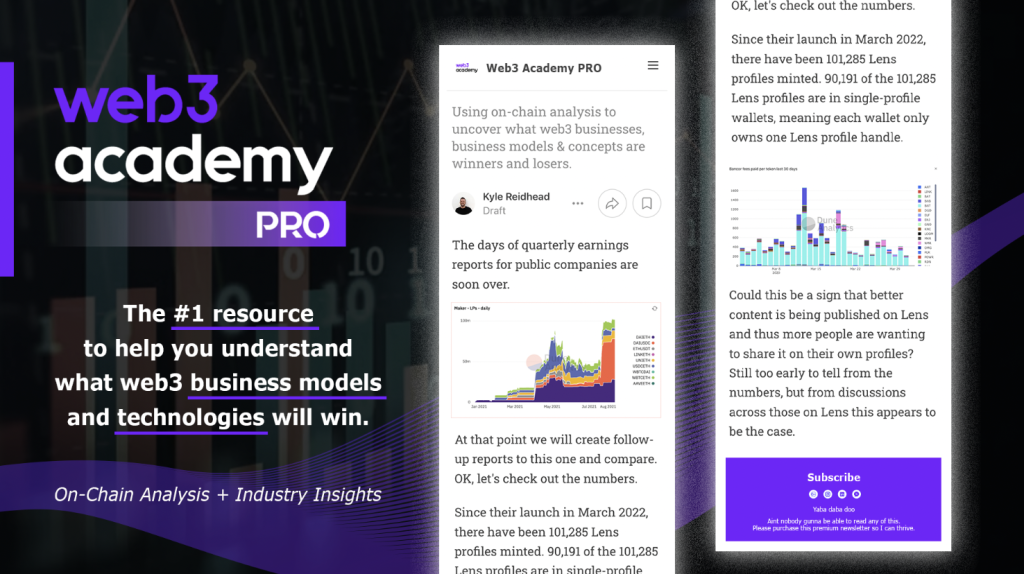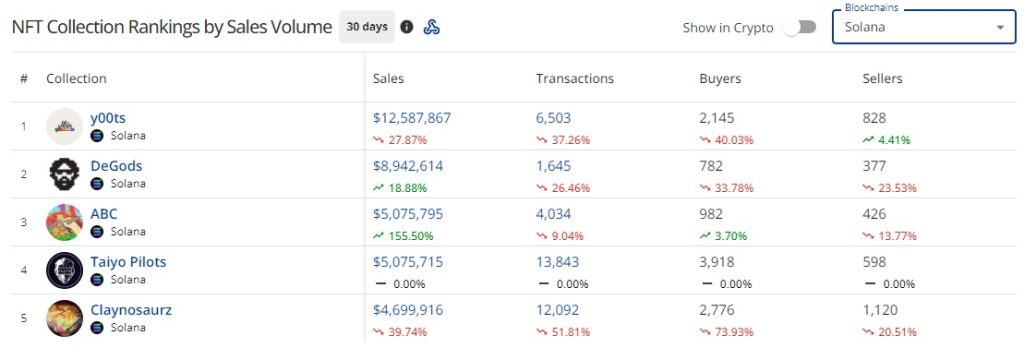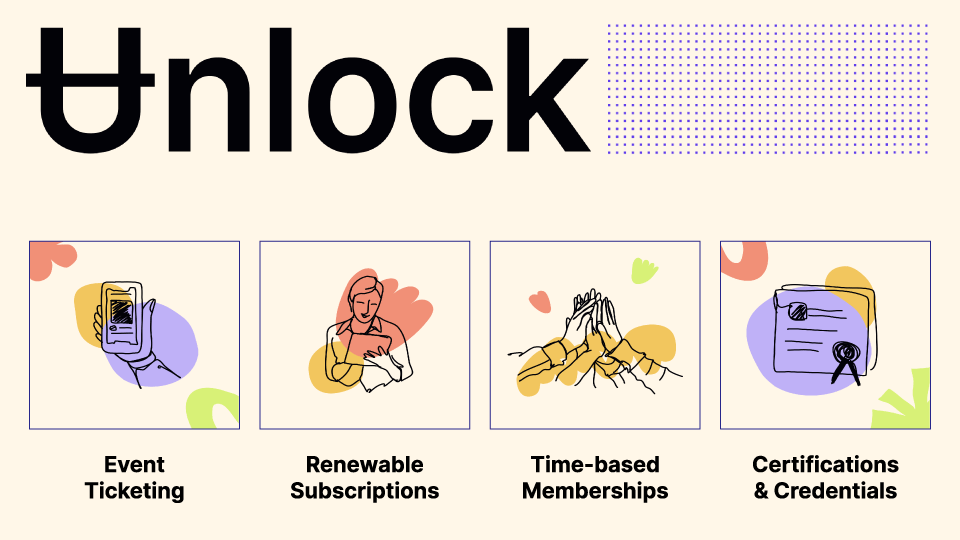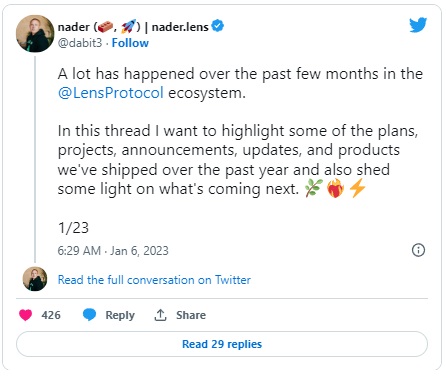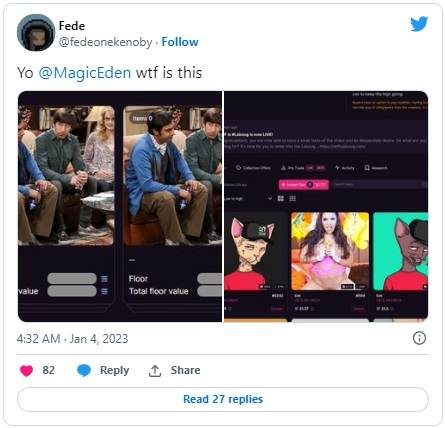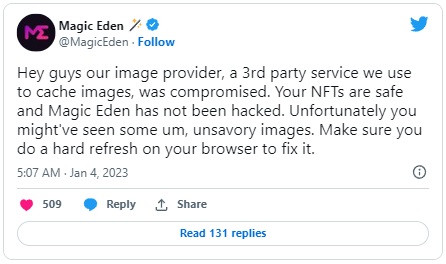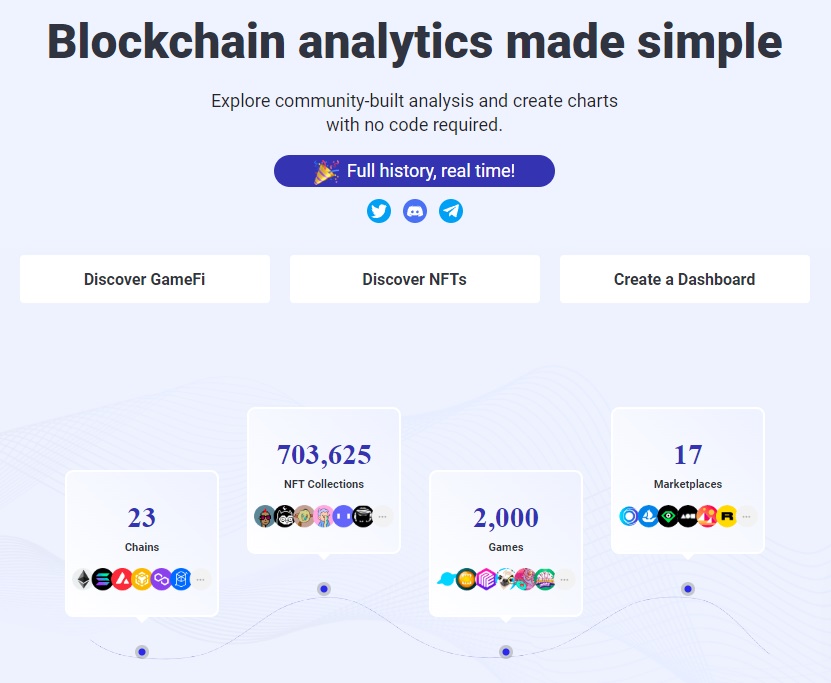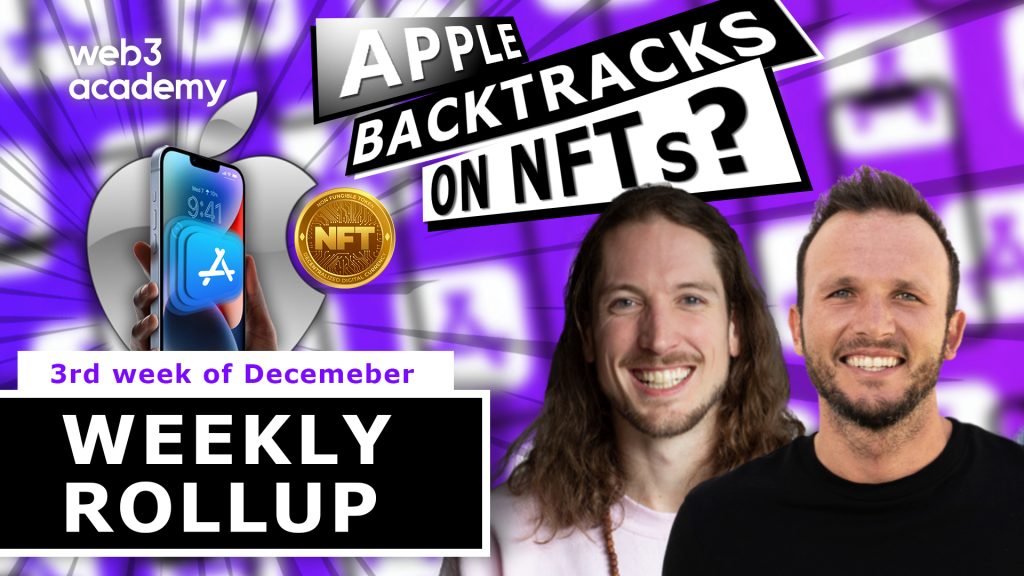
From ETH Killer to Sam Coin: Is Solana Dead?
OpenSea Cuts Cubans | Magic Eden Gets Hacked | Web3 Academy PRO Launched
GM DOers!
We hope that you took the last week or so to rest, relax, and unwind because 2023 is kicking off with some big news—and the Weekly Rollup is here to bring you up to speed.
Here’s what you might have missed during the break:
- Has FTX, Alameda, and Dust Labs put the final nail in Solana’s coffin? ⚰️
- OpenSea reminds us that it’s a web2 company by banning Cubans ❌
- Magic Eden got hacked (but it isn’t what you think) 😲
- Tool of the Month. Hint: it has something to do with Web3 Academy PRO⛓️
But before we dive in, we’ve got an exciting announcement.

VERIFY, DON’T TRUST
Web3 Academy PRO is Here!
Frens, after months of teasing, the long-awaited Web3 Academy PRO has arrived.🥳
Our first PRO report on the Activity & Growth of Lens Protocol hit your inbox on Thursday and the feedback was phenomenal. 🤯
We looked on-chain & combined the data with industry insights to determine the growth, activity, and, most importantly, the health of Lens Protocol & its dApps.
We’ve only scratched the surface of what’s possible with on-chain analysis in this first report but you now hopefully have an idea of how powerful this resource will become. 🚀
The truth is in the data! And due to the transparent nature of web3, we can now verify the data ourselves.
Web3 Academy PRO is the resource that’ll deliver this data, every week, in a digestible, actionable format so you can make informed decisions about where you want to build, create, or invest! 👀
At some point this month, the PRO reports will be behind a paywall.
But since you’re an early reader & supporter, we wanted to give you lifetime access to Web3 Academy PRO at a 50% discount right now! 🤩
Hurry though, this offer is only available to the first 100 DOers that sign up—and almost half of the spots have already evaporated in the first 2 days. 😳
There are also over 5,000 DOers reading this right now so you’ve got competition. 😅
P.S. Substack may need your email before you can access the sign-up page!
Now, let’s dive into the news.

THE CONTAGION CONTINUES
Is It Time to Buy Solana a Coffin?
That’s the question on many peoples’ minds right now.
And it’s no surprise since the blockchain was hit hard during the FTX debacle since its sister company, Alameda Research, held a staggering 10% of all $SOL (around 58 million tokens).
But to make matters worse, Dust Labs, the parent company of two prominent Solana NFT projects, announced that it would be bridging its collections to other chains. The collections in question were DeGods (which is moving to Ethereum) and Y00ts (which is moving to Polygon).
This announcement caused a serious stir in the Solana community as these two collections accounted for almost 70% of all NFT sales volume on the chain in recent weeks.
However, over the last 30 days, things aren’t looking so bleak.
Now, this move isn’t a complete shock as the projects have teased the move previously.
It’s also rumored that DeGods asked the Solana Foundation for a $5 million grant to stay on the blockchain (which didn’t go through). This rumor wasn’t confirmed by DeGods, but a Solana rep did confirm the figure in an interview with CoinDesk.
But what’s interesting is that Y00ts will receive a non-equity grant from Polygon worth $3 million to support the collection with its move and subsequent endeavors on the new chain.
That means Polygon clearly sees this as a big opportunity to have a prominent web3 collection on its chain which is currently home to some large web2 companies—i.e., Starbucks, Ticketmaster, Reddit, etc.)
And, naturally, it’s a big opportunity for Dust Labs and its family-friendly Y00ts collection to score some serious corporate partnerships.
But back to the “death” of Solana.
If we look on-chain, we can see that the chain’s total value locked (TVL) is significantly lower than it was during the bull market, going from roughly $10 billion down to under $300 million.
But, as you know, price (or TVL) isn’t the most important health metric of a blockchain—it’s about the community and developer activity.
So if you really want to know if Solana is dead or not, you need to do a thorough on-chain analysis. But if you haven’t got the time, Web3 Academy will do it for you!
All you need is to sign up for PRO and request a report on Solana (or any other blockchain).
While it’s not easy to convince Kyle, you already know he’ll do anything for the community. 😉
🤝 Together with Unlock Protocol: NFT Ticketing is the Future. Learn How to Easily Create and Sell NFT Tickets for Your Next Event!⚡

WEB3 IN THE FRONT, WEB2 IN THE BACK
OpenSea Blocks Cuba from Using Its Platform
Before Christmas, Cuban creators received an email saying that their OpenSea accounts have been disabled.
Now, the reason for the ban is that the United States has sanctions against Cuba and since OpenSea is an American corporation, it has to follow local laws. This isn’t the first time the platform has done this either with it previously blocking access from certain middle eastern countries.
But it’s not just Cubans that are affected. It’s anyone that is currently living on any of the country’s many islands.
One thing to note is that OpenSea is not a true web3 company. It’s a company that uses and integrates into web3 technologies but is actually no different than Twitter and other centralized web2 companies.

In the grand scheme of things, this isn’t actually a big deal because OpenSea can’t control users outside of its own platform—and that’s the beauty of web3. While Cubans and ex-pats in the country can’t use OpenSea, they’re free to move their NFTs to other exchanges, such as LooksRare, x2y2, and others.
This recent announcement is also a testament to why decentralization will fix some of the biggest issues with the internet right now, access and control.
Another example of why we need decentralization comes from one of our marketing agency clients.
Their entire business was on Revue, a newsletter platform that previously integrated with Twitter. Now, we did move our client onto their own custom site a while ago now, but they still had hundreds of subscribers through the platform.
Fast forward to the 20th of December and suddenly Elon decided to shut down Revue (since Twitter bought the company).
And the next thing we knew, our client immediately lost 700 of their paid subscribers just like that—no email or notification… nothing! Luckily we were able to fix the situation since Revue’s data would only be deleted on the 18th of January.
But this just goes to show that traditional web2 corporations don’t give a single damn about their users. They don’t care whether you miss out on thousands in revenue or whether your entire business runs on their platforms. It simply doesn’t matter to them.
And that’s why we need web3. To make sure that we control our data, money, content, and identities.

SOCIALS
Thread of the Week
To follow our recent on-chain dive into Lens Protocol, here’s the perfect recap of the social graph since its genesis, by our previous DOer Spotlight guest, Nader.

THE PROBLEM WITH NFT METADATA
Magic Eden Vendor Suffers Hack
Out of all the hacks that have happened in web3, Magic Eden’s is probably the funniest (or weirdest) so far—but thankfully, no one lost their NFTs or funds in the process.
In a nutshell, if you used Magic Eden’s in the past week, you may have noticed that your typical NFT JPEG was replaced by some unsavory pornographic images. Although, some people were lucky enough to get Big Bang Theory images instead.
What actually happened was that one of Magic Eden’s vendors, which handles the platform’s image caching, was the one that got hacked. Now, ME noticed this pretty quickly and responded with a tweet.
In the end, there weren’t any serious consequences to the hack. But it highlights some important lessons about NFTs:
- The image doesn’t affect the token’s utility whatsoever
- And the only reason this “hack” happened was that most projects don’t store media (e.g., pictures) on-chain.
We talked about this media storage situation roughly a month ago when we covered Moon Birds’ announcement that they’re putting their art on-chain (although they called it in-chain for marketing purposes).
Now, the reason that images and other media aren’t on-chain is that storage is expensive—plus it adds extra complexity to the project. So companies rely on web2 storage facilities (which are easier to hack than blockchains) to house their media.
👉 We dove deeper into this issue with Kyle Tut on a previous DOer Spotlight if you want to learn more about it.
But the biggest lesson here is that NFTs are just file wrappers.
They can function as a unique identifier of a particular piece of music, a video, an image, or even a PDF.
Now, in some cases, for example, with music, it’s obviously important that the NFT is linked to the right media so that you can listen to the song. But the cool part is that even if someone Rick Rolled your music NFT, you’d still have access to the underlying utility, such as token-gated access, staking, etc.

PSA to creators: It’s probably best to put your media in a decentralized storage platform, such as Pinata, so you don’t have to deal with this situation—especially if you’re building web2 brand partnerships.

TOOL OF THE MONTH
Footprint Analytics: Making On-Chain Data Accessible to All
After a bit of a break from our community competitions, we’re back with Tool of the Month.
It was on-chain analysis week and our community chose to pit Nansen, Glassnode, Dune, and Footprint Analytics (FA) against each other in what was sure to be a tight race.
While the juggernauts of the industry (Nansen and Dune) took an early lead, it was Footprint that came through with a strong upset, capturing 54% of the votes.
So a big congratulations to the FA team! 🎉
We actually had Footprint on our podcast previously, so if you want to dive deeper into what they’re doing, make sure to check it out.
With Web3 Academy PRO, we use a bunch of different analytics tools—mainly Dune to be completely honest. But the cool thing about Footprint is that they’re probably the most user-friendly platform of them all.
It’s similar to Dune in that it’s multi-chain with 23 different chains on Footprint alone. You can look at all the different NFT collections, games, marketplaces, or whatever tickles your fancy.
And the nice thing about Footprint Analytics is that it’s a no-code platform. So you can create charts and dashboards without knowing SQL or programming languages which opens on-chain analysis to everyone in the space.
Now, we’ve already discussed the power of on-chain analysis but it begs some repeating.
We believe that it’s one of the biggest unlocks of web3. We don’t have to trust the data that big companies disclose to us in the future because we can verify its legitimacy by ourselves whenever we feel like it.

It allows us to understand how different companies operate. It allows us to better understand our audience. And it allows us to uncover trends and transactions that may otherwise be hidden.
And so Footprint, Dune, Glassnode, and Nansen, are all tools that you can use to figure all this stuff out.
But if you want a gentler introduction or if you don’t wanna do the on-chain stuff yourself, just subscribe to PRO and we’ll serve weekly on-chain analyses coupled with battle-tested insights straight to your inbox.

NUMBERS TO KNOW
65
That’s how many feet the Nouns float was at the annual Rose Parade. Source
$100,000,000
That’s the settlement Coinbase will pay over compliance issues. Source
2,200,000
That’s how many ENS domains have been registered so far. Source

AROUND WEB3
Other Web3 News
- Mastercard launches web3 musician accelerator program in partnership with Polygon. Source
- Binance is the next to integrate Apple and Google Pay. Source
- Steve Aoki is selling a bunch of his NFTs. Does this mean the bottom is in? Source
- Blur changes stance on royalties… again. Source
- RECUR launches RECUR Builder, an enterprise-level SaaS platform for web3 operations. Source
- Venly, a Shopify merchant app, now allows the design, mint, and sale of NFTs (on the Avalanche network) through Shopify stores. Source
- US judge rules that customer crypto deposits on Celsius Network are property of the platform itself. Source
- Moonbirds sign with Hollywood talent agents UTA. Source
- McKinsey believes the metaverse could create $5 trillion in value by 2030. Source

FOR THE DOERS
Take Action & Level Up
READ
Check out the first edition of Web3 Academy PRO: Lens Protocol Activity & Growth: What Does the On-Chain Data Tell Us?
WATCH
Watch Web3 Academy’s Top Web3 Predictions for 2023 and let us know which ones you agree with!
LEARN
Take our FREE Web3 Rabbit Hole Course to get up-to-speed on the foundational components of Web3 so you can confidently build, work, or use the fastest-growing technology in history

